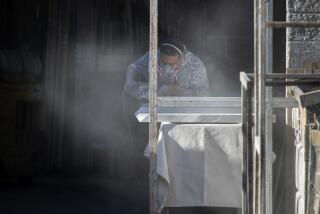Shedding light on work hours and breaks
The California Supreme Court handed workers a major victory Monday in a case involving overtime and meal and rest breaks.
Many workers don’t know their rights, and employers often don’t understand their responsibilities. Part of the confusion arises from the difference between federal and state regulations.
How do the California and federal rules differ?
California law is stricter than in most states, requiring that so-called nonexempt employees get a 30-minute, unpaid meal break for every five hours worked and a 10-minute, paid rest break for every four hours worked. Employees cannot waive their rights to these breaks to, for example, work through lunch and leave half an hour early.
There is no required lunch break under federal law.
Overtime pay kicks in for California nonexempt workers after they’ve worked more than eight hours in a day; federal regulations require time-and-a-half pay only if an employee works more than 40 hours in an entire workweek. As with meal and rest breaks, California employees may not voluntarily agree to give up overtime pay.
Who are exempt and nonexempt employees?
State labor regulations define exempt employees as professionals, such as physicians or certified public accountants; outside sales representatives; and managers who spend half
or more of their time on
supervisory duties. These employees aren’t entitled to overtime.
Nonexempt workers, a much larger group, are entitled to overtime.
Defining who is exempt and who is nonexempt, though, is a “big gray area,” says Cliff Palefsky, a San Francisco lawyer who represents workers.
Job titles don’t always tell the story, he says; the definition rests on the employee’s specific duties and the extent of his or her supervisorial responsibilities. So, for example, some computer technicians may be exempt while others are nonexempt. Ditto for administrators.
Plaintiffs in many wage-and-hour cases with titles such as manager or assistant manager claim they spend less of their days supervising than performing the same tasks as the workers they oversee. Lawyers say many white-collar workers in retail stores, restaurants, insurance companies, banks and many other businesses may have exempt-sounding titles
but actually should be nonexempt.
What did Monday’s decision settle?
Monday’s ruling settled the question of whether nonexempt employees who claim they were denied overtime or meal and rest breaks may ask for up to three years of back pay or only one. The court said three
years.
How many lawsuits are there?
No service tracks this litigation statewide, according to Michael Singer, a San Diego lawyer who represents workers. He estimates that 500 to 1,000 meal-and-rest-break class actions have been filed to date. And how many workers are involved? “Definitely hundreds of thousands,” Singer said.
If you’re an employer, how can you make sure you’re obeying the law?
The California Chamber of Commerce’s HR Watchdog blog (www.hrcalifornia.com) reviews Monday’s decision and discusses other employment law topics.
Spokesman Vince Sollitto says “wage-and-hour questions are consistently the No. 1 topic, by far” on the chamber’s members-only help line.
Make sure there is a clear job description on file for every employee, Palefsky advises. That description should specify the employee’s tasks and compensation and spell out managerial duties, if any.
Make sure employees leave their workstations during meal and rest breaks so there’s no question they’re off duty, advises Mark Schickman, a San Francisco attorney who represents employers.
State law imposes strict duties on employers to keep accurate records of workers’ hours and breaks, said Los Angeles lawyer Richard Simmons, who also represents employers. Employees may resent their bosses keeping close tabs on their comings and goings, he said, but time sheets and computer programs that track work hours “are an employer’s best ally in demonstrating compliance,” he advises.
What to do if you think you are owed overtime or back pay for missed meal and rest breaks?
Workers can file complaints with the state Division of Labor Standards Enforcement. The agency will convene a hearing on the dispute (www.dir.ca.gov/dlse/dlse.html). Workers unhappy with the hearing officer’s decision can file a de novo claim in Superior Court. They can also bypass the agency and file directly in court.
The high court held Monday that employees who file claims for back pay in Superior Court can raise additional wage-and-hour issues they didn’t bring to the labor standards board.
More to Read
Inside the business of entertainment
The Wide Shot brings you news, analysis and insights on everything from streaming wars to production — and what it all means for the future.
You may occasionally receive promotional content from the Los Angeles Times.










